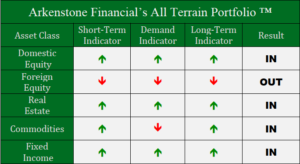Global stocks suffered significant losses in June, breaking key support levels in the process. Commodities followed suit, leaving the U.S. one of the few bright spots in the global economy.
Domestic Equity
The U.S. stock market experienced minor regression in June but continues its steady recovery following the February correction. Although the post-correction recovery hasn’t been particularly strong, the United States stock market is one of the few across the globe maintaining its long-term positive trends. The utilities sector has been leading the current recovery, along with the technology sector. The financial sector continues to lag behind the rest of the U.S markets, but this could just be a case of sector rotation. However, because we saw this same behavior prior to our last recession, it’s something we’ll monitor closely.
As anticipated, the Federal Reserve increased interest rates in June. However, no additional clarity on the number of remaining rate hikes for 2018 was provided. Currently, markets have priced in a 75% probability of one more rate hike (in September) and a 50% chance we see hikes in September and December this year.
Global Equity
Foreign stocks fell through key support in June. This breakdown contributed to a 6% loss in the month of June. In the process, both short-term and long-term uptrends were broken—a concerning sign for the recent coordinated global growth. To further emphasize this breakdown, approximately 85% of commonly traded countries are now in the red for the year.
Emerging Markets were a key contributor to this global breakdown, but perhaps none more than China. China entered bear market (a 20% decline since February) territory by the end of June. As the world’s second-largest economy, and home to a relatively fragile banking system, the long-term implications of this pull back could be substantial. A weakening dollar and relief on trade could help China. For right now, China’s stock market remains very weak relative to the United States.
Real Estate
Real Estate continues to build momentum off its lows of 2018, tacking on 3% of growth in June. On a relative basis, real estate has been stronger than the U.S. stock market since April. Investors continue to favor the high yield of real estate funds, driving up prices in the process. Despite this hot market, there is reason for concern: Real estate is quickly approaching a price level that it has failed to break through twice in the last two years. Another failed breakthrough could result in a substantial pull back.
Commodities
Commodities were down to the tune of a 6.5% loss in June. However, relief seems to be in sight as the U.S. dollar (a major headwind for commodities) is showing signs of retreating. Momentum (and demand) for U.S. dollars has been steadily falling as prices increase. Generally, when this type behavior exists, a sharp reversal in price will follow. This should provide a much-needed boost to precious metals as they are hovering around their one year low.
Fixed Income
Bonds were slightly up in June as the wild yield swings we saw in May retreated to allow for a very calm month. Unfortunately, when bond prices increase their yields decrease. The long-term treasury notes (10, 20, and 30 year) all continue to see their yields fall while shorter term note yields increase. This is certainly a concerning path for yields, and one we will continue to monitor. For now, this makes traditional bond funds worth avoiding.
All Terrain Portfolio Update
The All Terrain Portfolio carries its cautious investment approach into July. Although we witnessed a few short term positives in June, we will continue to closely monitor our indicators, key support, and technical levels.

Past performance is not indicative of future results. Other asset classes or investment vehicles may be used in client portfolios and client portfolios may not hold all positions of the model at the same time as the model. This chart and its representations are only for use in correlation to the proprietary timing model by Arkenstone Financial, Registered Investment Advisor. Actual client and All Terrain Portfolio(TM) positions may differ from this representation.
- U.S. Stocks Make New Highs - December 6, 2024
- Rising Rates Create Headwinds - November 8, 2024
- The Fed Finally Cuts Rates - October 10, 2024



Leave a Reply